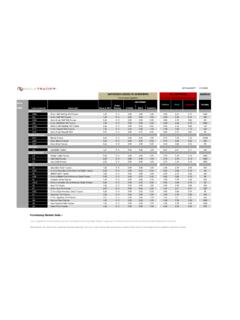Transcription of TREASURY DEPARTMENT TECHNICAL EXPLANATION OF THE ...
1 TREASURY DEPARTMENT TECHNICAL EXPLANATION OF THE CONVENTIONBETWEEN THE UNITED STATES OF AMERICA AND CANADA WITH RESPECT TOTAXES ON INCOME AND ON CAPITAL SIGNED AT WASHINGTON, ONSEPTEMBER 26, 1980, AS AMENDED BY THE PROTOCOL SIGNED AT OTTAWA ONJUNE 14, 1983 AND THE PROTOCOL SIGNED AT WASHINGTON ON MARCH 28, EFFECTIVE DATE UNDER ARTICLE XXX: 1 JANUARY 1985 INTRODUCTIONThis is a TECHNICAL EXPLANATION of the Convention between the United States and Canadasigned on September 26, 1980, as amended by the Protocols signed on June 14, 1983 and March28, 1984. ("the Convention"). References are made to the Convention and Protocol betweenCanada and the United States with respect to Income Taxes signed on March 4, 1942, asamended by the Convention signed on June 12, 1950, the Convention signed on August 8, 1956and the Supplementary Convention signed on October 25, 1966 (the "1942 Convention").
2 Thesereferences are intended to put various provisions of the Convention into context. The technicalexplanation does not, however, provide a complete comparison between the Convention and the1942 Convention. Moreover, neither the Convention nor the TECHNICAL EXPLANATION is intended tohave implications for the interpretation of the 1942 TECHNICAL EXPLANATION is an official guide to the Convention. It reflects policiesbehind particular Convention provisions, as well as understandings reached with respect to theinterpretation and application of the OF ARTICLESA rticle I----------------------------------Perso nal ScopeArticle II---------------------------------Taxes CoveredArticle III--------------------------------Gener al DefinitionsArticle IV--------------------------------Reside nceArticle V---------------------------------Perman ent EstablishmentArticle VI--------------------------------Income from Real PropertyArticle VII-------------------------------Busine ss ProfitsArticle VIII------------------------------Transp ortationArticle IX--------------------------------Relate d PersonsArticle X---------------------------------Divide ndsArticle XI--------------------------------Intere stArticle
3 XII-------------------------------Royalt iesArticle XIII------------------------------GainsA rticle XIV------------------------------Indepen dent Personal ServicesArticle XV-------------------------------Depende nt Personal ServicesArticle XVI------------------------------Artiste s and AthletesArticle XVII-----------------------------Withhol ding of Taxes in Respect of IndependentPersonal ServicesArticle XVIII----------------------------Pension s and AnnuitiesArticle XIX------------------------------Governm ent ServiceArticle XX ------------------------------StudentsAr ticle XXI------------------------------Exempt OrganizationsArticle XXII-----------------------------Other IncomeArticle XXIII----------------------------Capital Article XXIV----------------------------Eliminat ion of Double TaxationArticle XXV-----------------------------Non-Disc riminationArticle XXVI----------------------------Mutual Agreement ProcedureArticle XXVII---------------------------Exchange of InformationArticle XXVIII--------------------------Diplomat ic Agents and Consular OfficersArticle XXIX----------------------------Miscella neous RulesArticle XXX-----------------------------Entry into ForceArticle XXXI----------------------------Terminat ionProtocol 3--------------------------------of 17 March, 1995 Protocol 4--------------------------------of 29 July.
4 1997 ARTICLE IPersonal ScopeArticle I provides that the Convention is generally applicable to persons who areresidents of either Canada or the United States or both Canada and the United States. The word"generally" is used because certain provisions of the Convention apply to persons who areresidents of neither Canada nor the United IITaxes CoveredParagraph I states that the Convention applies to taxes "on income and on capital"imposed on behalf of Canada and the United States, irrespective of the manner in which suchtaxes are levied. Neither Canada nor the United States presently impose taxes on 1 is not intended either to broaden or to limit paragraph 2, which provides that theConvention shall apply, in the case of Canada, to the taxes imposed by the Government ofCanada under Parts I, XIII, and XIV of the Income Tax Act and, in the case of the United States,to the Federal income taxes imposed by the Internal Revenue Code ("the Code").
5 National taxes not generally covered by the Convention include, in the case of the UnitedStates, the estate, gift, and generation-skipping transfer taxes, the Windfall Profits Tax, Federalunemployment taxes, social security taxes imposed under sections 1401, 3101, and 3111 of theCode, and the excise tax on insurance premiums imposed under Code section 4371. TheConvention also does not generally cover the canadian excise tax on net insurance premiumspaid by residents of Canada for coverage of a risk situated in Canada, the Petroleum and GasRevenue Tax (PGRT) and the Incremental Oil Revenue Tax (IORT). However, the Conventionhas the effect of covering the canadian social security tax in certain respects because underCanadian domestic tax law no such tax is due if there is no income subject to tax under theIncome Tax Act of Canada.
6 Taxes imposed by the states of the United States, and by theprovinces of Canada, are not generally covered by the Convention. However, if such taxes areimposed in accordance with the provisions of the Convention, a foreign tax credit is ensured byparagraph 7 of Article XXIV (Elimination of Double Taxation).Paragraph 2 contrasts with paragraph 1 of the Protocol to the 1942 Convention, whichrefers to "Dominion income taxes." In addition, unlike the 1942 Convention, the Conventiondoes not contain a reference to "surtaxes and excess-profits taxes."Paragraph 3 provides that the Convention also applies to any taxes identical orsubstantially similar to the taxes on income in existence on September 26, 1980 which areimposed in addition to or in place of the taxes existing on that date.
7 Similarly, taxes on capitalimposed after that date are to be was agreed that Part I of the Income Tax Act of Canada is a covered tax even thoughCanada has made certain modifications in the Income Tax Act after the signature of theConvention and before the signature of the 1983 Protocol. In particular, Canada has enacted alow flat rate tax on petroleum production (the PGRT) which, at the time of the signature of the1983 Protocol, is imposed generally at the statutory rate of percent for the period June 1,1982 to May 31, 1983, and at 16 percent thereafter, generally reduced to an effective rate of 11percent or 12 percent after deducting a 25 percent resource allowance. The PGRT is notdeductible in computing income for canadian income tax purposes.
8 This agreement is notintended to have implications for any other convention or for the interpretation of Code sections901 and 903. Further, the PGRT and IORT are not taxes described in paragraphs 2 or 4 provides that, notwithstanding paragraphs 2 and 3 the Convention applies tocertain United States taxes for certain specified purposes: the accumulated earnings tax andpersonal holding company tax are covered only to the extent necessary to implement theprovisions of paragraphs 5 and 8 of Article X (Dividends); the excise taxes imposed with respectto private foundations are covered only to the extent necessary to implement the provisions ofparagraph 4 of Article XXI (Exempt Organizations); and the social security taxes imposed undersections 1401, 3101, and 3111 of the Code are covered only to the extent necessary to implementthe provisions of paragraph 4 of Article XXIX (Miscellaneous Rules).
9 The pertinent provisionsof Articles X, XXI, and XXIX are described below. Canada has no national taxes similar to theUnited States accumulated earnings tax, personal holding company tax, or excise taxes imposedwith respect to private II does not specifically refer to interest, fines and penalties. Thus, eachContracting State may, in general, impose interest, fines, and penalties or pay interest pursuant toits domestic laws. Any question whether such items are being imposed or paid in connectionwith covered taxes in a manner consistent with provisions of the Convention, such as ArticleXXV (Non-Discrimination), may, however, be resolved by the competent authorities pursuant toArticle XXVI (Mutual Agreement Procedure). See, however, the discussion below of thetreatment of certain interest under Articles XXIX (Miscellaneous Rules) and XXX (Entry IntoForce).
10 ARTICLE IIIG eneral DefinitionsArticle III provides definitions and general rules of interpretation for the 1(a) states that the term "Canada," when used in a geographical sense, means theterritory of Canada, including any area beyond the territorial seas of Canada which, underinternational law and the laws of Canada, is an area within which Canada may exercise rightswith respect to the seabed and subsoil and their natural resources. This definition differs only inform from the definition of Canada in the 1942 Convention; paragraph 1(a) omits the referencein the 1942 Convention to "the Provinces, the Territories and Sable Island" as 1(b)(i) defines the term "United States" to mean the United States of term does not include Puerto Rico, the Virgin Islands, Guam, or any other United Statespossession or 1(b)(ii) states that when the term "United States" is used in a geographicalsense the term also includes any area beyond the territorial seas of the United States which,under international law and the laws of the United States, is an area within which the UnitedStates may exercise rights with respect to the seabed and subsoil and their natural 1(c)
















